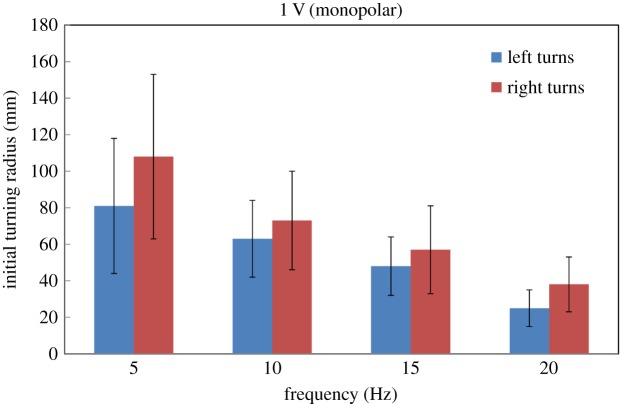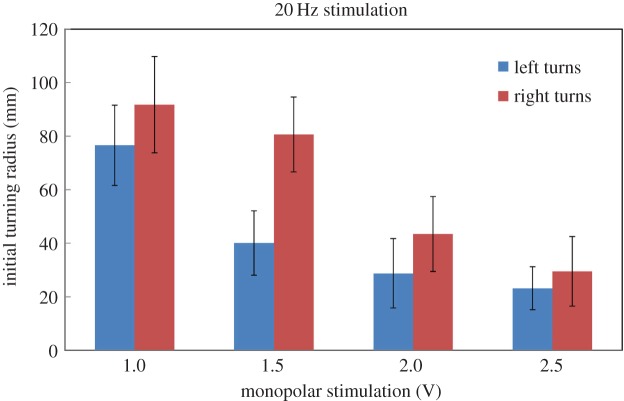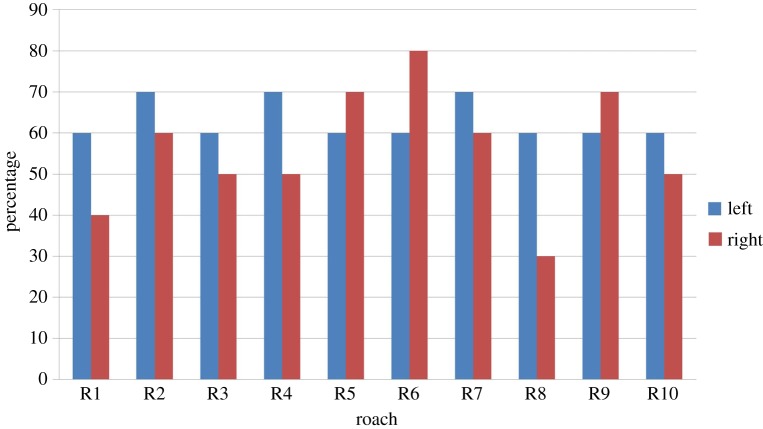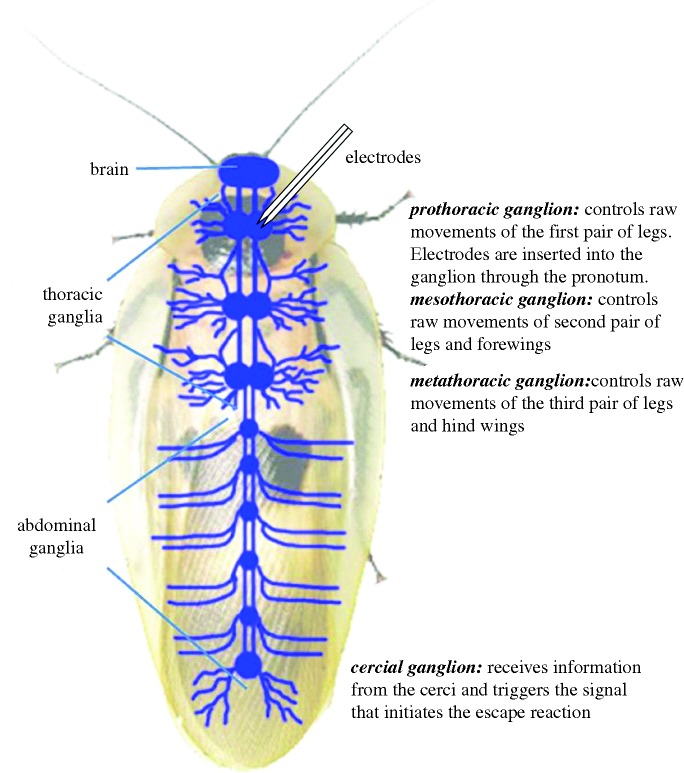Abstract
Natural systems retain significant advantages over engineered systems in many aspects, including size and versatility. In this research, we develop a hybrid robotic system using American (Periplaneta americana) and discoid (Blaberus discoidalis) cockroaches that uses the natural locomotion and robustness of the insect. A tethered control system was firstly characterized using American cockroaches, wherein implanted electrodes were used to apply an electrical stimulus to the prothoracic ganglia. Using this approach, larger discoid cockroaches were engineered into a remotely controlled hybrid robotic system. Locomotion control was achieved through electrical stimulation of the prothoracic ganglia, via a remotely operated backpack system and implanted electrodes. The backpack consisted of a microcontroller with integrated transceiver protocol, and a rechargeable battery. The hybrid discoid roach was able to walk, and turn in response to an electrical stimulus to its nervous system with high repeatability of 60%.
Keywords: biotechnology, hybrid robotics, insect control
1. Introduction
The development of autonomous robotic systems has been of great interest to scientific and engineering communities [1–3]. Researchers have studied the rapid and agile locomotion that is commonly performed by different animals, particularly insects, as models for robotic systems [1,4–7]. By mimicking the control mechanisms and physical structures of natural biological systems, engineers are able to design mechanical robotic systems to optimize their performance [2,8,9]. Hybrid robotic systems using insects have attracted particular attention in recent years [10,11]. The goal of those studies has been to remotely control insects with the purpose of taking advantage of their natural movements [2,8,9,12]. However, establishing efficient control of the natural leg movements of living insects has proven to be a difficult task [10,13,14]. One of the effective approaches was used by Holzer & Shimoyama [6], who observed the reaction of living insects to electrical stimulation. Through the use of controlled electrical stimulation applied to a cockroach's nervous system, the researchers observed reactions similar to those seen under natural conditions in the roach while in the presence of a predator. A backpack system was thus developed to generate electrical stimuli transmitted through wires implanted in the antennal sockets of a cockroach. Using this method, researchers were able to obtain some level of control of walking direction by taking advantage of the roach's natural tendency to move away from sensory data received through their antennae [15]. However, reduced responsiveness was observed as the roach appeared to become habituated to the stimuli. Habituation is a problem as the tissue often becomes less responsive over time, and the roach learns to ignore artificial stimuli [5,12,15,16]. Studies have been performed to understand and alleviate the tissue trauma when using neuro-stimulators [5,16,17]. To date, new materials and electronic systems have provided new interest for alternative methods. A better level of control and response of robotic systems must be developed in order to improve the overall performance of such a system. We report the development of a new approach to using electrical stimulus to control cockroaches' movements. Significantly improved repeatability and consistency in response were achieved.
In order to effectively control the movements of a cockroach through electrical stimulation, it was clearly necessary to understand the complex behaviour of the nervous system of the roach, including stimulation of ganglia and motor neurons [18,19]. We have recently studied cockroach control mechanisms through in vivo and in vitro antennae and cerci stimulation with American cockroaches [11,12]. Those works have successfully demonstrated that antenna, antennal sockets and cerci stimulation are viable means of control but they are not as effective as previously found [5,6,15]. Furthermore, in all reported cases it was shown that the test roaches become conditioned to the stimuli and begin to ignore the sensory feedback after a few trials. Locomotion control will last only for short periods of time until it ceases all together [6,14,15]. Methods used to control a cockroach through implanting electrodes in antenna sockets essentially work by tricking the roach into ‘sensing’ an obstruction which it then tries to move away from. Stimulating the right antenna, the roach will ‘think’ an object or a threat is present on its right side and attempt to move away from it to the left. It is worth noting that prior research has also shown that cockroaches can be conditioned to trail certain odours, and thus the antennae seem to be highly susceptible to conditioning [11]. That is, the roach will tend to ignore sensory feedback from the antenna based on information gathered from other senses. This is the primary limitation to stimulating sensory channels such as antenna and cerci; the stimulation can only trick the roach for so long until it learns to ignore it. In the current study, a novel approach of locomotion control through ganglia stimulation was accomplished through precise placement of electrodes and manipulation of electrical signals applied to the nervous system. Directly stimulating the nervous system allows for more direct control of the cockroach's natural movements and eliminates the issue of conditioned behaviour. Electrical signals were delivered through a wireless electronic backpack attached to the cockroach, allowing for remote control of locomotion. Stimulating certain ganglia will affect the legs attached to a particular segment of the roach. As the roach walks or runs, its normal gait may be disrupted by applying an electrical signal to a particular nerve cluster. The stimulation will cause a particular leg to become out of phase with the normal gait, thereby causing a turning motion in a desired direction.
Hybrid robotic systems have significant advantages over conventional engineered robotic systems. Hybrid systems using living insects that are small, have an efficient sensory system, and respond to their environments through multiple feedback channels. Such living systems can be self-powered through in-taking water, air and food. These hybrid robots utilize the behaviours of insects combined with electronics, and can be used in many applications where conventional robots cannot be efficiently employed. Hybrid insect robots are expected to enable new advances in deployment, search and rescue, and information gathering operations. They will benefit areas such as homeland security, emergency services, construction and mining. The uniqueness of this research is in the integration of robotic systems with a living organism as a platform. The knowledge gained will be used to integrate the two systems, resulting in a controllable hybrid robot that maintains the unique attributes of a living and responsive biological system.
2. Results
The backpack used for wireless control consisted of a small printed circuit board (PCB), wire electrodes and a rechargeable lithium polymer battery. The low profile circuit board weighs 1.4 g and is 16.5 mm square. The circuit board contained small female header pins for insertion of the electrodes. A rechargeable lithium polymer battery (3.7 V, 50 mAh) was used as the power source and weighed 1.5 g. The entire system (circuit board with electronic components, battery, connecting wires and implant electrodes), weighed approximately 3.0 g. The complete backpack system can be seen placed on a discoid cockroach in figure 1.
Figure 1.

Discoid cockroach with attached electronic backpack (battery on top, board attached to the forewings). The electrodes enter the body through the pronotum. (Online version in colour.)
Tethered and remote-controlled experiments were recorded using an overhead digital camera. The resulting locomotion of the cockroaches was then analysed using imaging software to obtain the consistency in response, and to plot the path taken for an initiated turn. Figure 2 illustrates a typical left initiated turn for a tethered American cockroach. For any given experiment, the cockroach will tend to move in various directions and at various angles along its walking path. Therefore, only the initial movements after the applied stimulation was measured and used as a baseline for the remote-controlled experiments. The initial turning movements were quantified by superimposing an axis with the origin at the roach's start position, then mapping out its movements at 0.5 s intervals in the lateral and vertical directions. The turning radius was determined by superimposing a circle that best fit the initial curvature of the path. The measurement process is illustrated in figure 2. The controllability of a roach, in terms of success rate, was subjectively rated based on user observation. If the user was able to successfully have the cockroach turn in a desired direction, then a run was deemed successful. Numerous successful runs dictated a roach that exhibited consistent responses.
Figure 2.
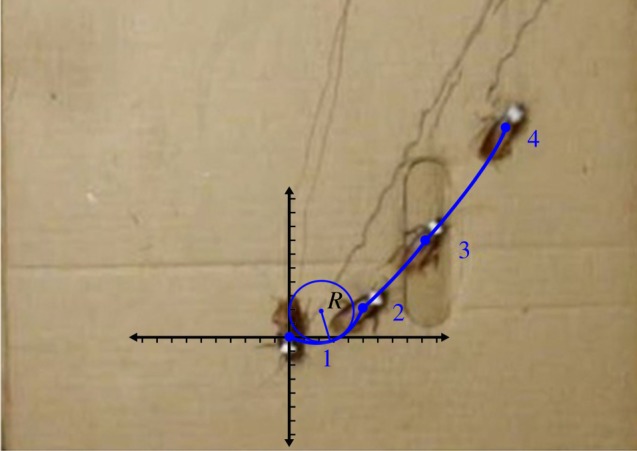
Example of a typical turning experiment using a tethered American cockroach. The image shows a left turn controlled by electrical stimulation. The wire electrodes and leash are seen as dark lines in the image. The path of the roach is mapped by superimposing an axis at the start position, then marking its location at 0.5 s intervals. The initial turning radius is computed by fitting a circle of radius R to the starting curvature of the path. (Online version in colour.)
The turning radii results for the tethered experiments involving the American cockroaches can be seen in figures 3 and 4. For these trials, 10 cockroaches were stimulated to turn 10 times to the left and 10 times to the right, for a total of 20 trials. The average testing time for all roaches was approximately 45 min to complete each trial. This time does not reflect time of consistency in response, but the time required to collect the 20 data points. Each roach was allowed to rest for at least 2 min between each trial. The purpose of the tethered experiments was to gain a better understanding of the electrical signal characteristics that were necessary for optimum control. Figure 3 shows the turning radius after applying a 1 V, monopolar signal, a signal with a stable state of 0 V and a varying state of higher voltage, to the cockroach ganglia at increasing frequencies. The results show that the turning radius decreases (i.e. sharper turns) as the frequency of the input signal increases. Based on these results, an investigation was carried out on the frequency that elicited the sharpest turning radius, 20 Hz. Figure 4 shows the turning radius after applying a 20 Hz signal at increasing voltage. The results show that the turning radius decreases as the voltage increases. However, stimulation frequency appeared to be the more effective control parameter than that of input voltage. The output signal can be set at a constant low voltage (1 V), which will reduce power consumption and increase the life of the electronic backpack. This trend coincides with results obtained in our previous studies involving American cockroaches walking on a trackball system [12]. The overall success rate of initiating and sustaining a turn in a desired direction (i.e. left or right turns) was approximately 70%. The remaining 30% of trials were unsuccessful in regard to roaches not moving when stimulated, turning in the wrong direction or moving without turning in either direction. The signal characteristics of the tethered study were then applied to the remote-controlled experiments using the larger discoid cockroach. A constant input voltage was chosen, while the stimulation frequency was chosen by the user during the course of a trial. The signal used was 2.5 V, and a frequency range of 1–20 Hz was implemented in order to obtain an optimum turning during each trial. Using this methodology, a roach should make sharper turns at higher frequency stimulation, and wider turns at lower frequencies.
Figure 3.
Plot of the measured turning radius for 20 trials using 10 tethered American cockroaches for a constant 1 V signal and varied frequency. Increasing the frequency will reduce the initial turning radius, leading to sharper turns. (Online version in colour.)
Figure 4.
Plot of turning radius for 20 trials using 10 tethered American cockroaches for a constant 20 Hz signal with varied output voltage. The turning radius becomes smaller with increased voltage, leading to sharper turns. (Online version in colour.)
Discoid cockroaches, with an electronic backpack attached were allowed to walk/run freely while a researcher attempted to control the directionality of its movements. A total of three users were given an opportunity to control a tethered and a remote cockroach over the course of this study. Controllability was determined by how well the user was able to initiate a turn in the cockroach as it walked or ran across the floor. The goal of these experiments was to test the responsiveness of the roaches to the varied electrical stimulus. Applying a controlled electrical stimulus to the pro-ganglion elicits movement in the first set of legs in the roach. This will cause the contralateral leg to become out of phase with the normal gait of the roach, which will initiate a turning motion. Stimulating the right side of the ganglion initiated turning to the left direction by the cockroach. Similarly, left side stimulation initiated turning to the right direction. In addition, it was found that any monostable signal above 2 V applied for a long period will cause the cockroach to stop walking or running. Application of another asymmetric signal will re-initiate movement. All test trials were recorded by an overhead digital camera, and later evaluated with imaging software. The researcher operating the controls attempted to manoeuvre the cockroach left and right during any given test. A total of 20 trials were performed on each roach, attempting to induce 10 left turns and 10 right turns. The goal of each trial was to make the roach turn into a pre-determined area on the right or left side of a central axis. Controlling the roach to turn into this area, regardless of path taken, signified a successful trial. The maximum area seen by the overhead camera was marked off with tape to act as a bounding box for the experiments. No other form of indicator was used within the experimental area so as to not influence the roach's movements. At the start of each trial, a researcher would place the roach towards the bottom of the test area, and close to the centre line. He would then attempt to control the roach to turn into a pre-designated area. This area is a 75 mm circle that is centred approximately 200 mm lateral and 300 mm vertical to the roach's initial position. This is an arbitrary area and was physically marked by the researchers using small blocks placed on the outside of the testing area. A trial was deemed successful if the roach was controlled to move into this area. A trial was determined to be unsuccessful if a roach did not move when a stimulus was applied, not turning in the intended direction, or moving forward without turning. Each roach was allowed to rest for 3 min between trials, and then made to turn in the opposite direction of the previous trial. Since each roach behaved differently during testing, the total experiment for each roach took an average of 1 h. The path taken by a roach for each trial was then mapped out using imaging software to superimpose an axis at the start position and measuring locations at 0.5 s intervals. The initial response time, and the average speed for each run were also determined. The general test set-up and methodology for mapping the path taken by each roach is shown in figure 5. Figures 6 and 7 show the path lines for one roach (R1) turning left and right, along with the initial response times and average speed for each trial. The paths taken by this roach over the numerous trials are varied in pattern, which was similarly observed for all the roaches. Likewise, the amount of time that it takes for the roach to respond to the initial stimulus at the start of the tests tends to increase over the number of trials. The reduced responsiveness over time was observed for all roaches tested. However, the average speed of the roach over the numerous trials did not exhibit a trend. The velocity for all roaches was varied, and each roach had varied velocities over all trials. The overall success rate using the remote backpack system was approximately 60%, meaning that the researcher was able to control the roach into the designated area six times out of 10. The success rate for each of the roaches tested can be seen in figure 8, with R1 being the roach whose path lines are plotted in figures 6 and 7. It was observed that each of the roaches remained responsive throughout the course of the hour-long experiment. Statistically, controlling a roach to turn left had a higher success rate than turning right (63% ± 4.8 versus 56% ± 15.0).
Figure 5.
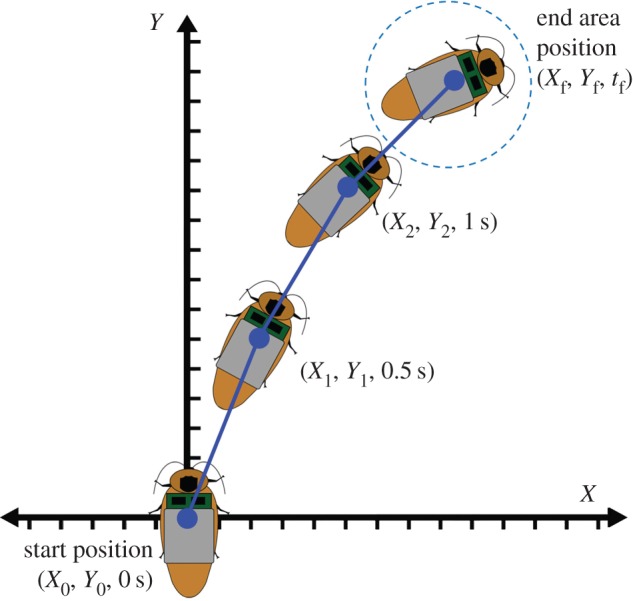
Turning movements were tracked by superimposing an axis at the roach's start position. The roach was then mapped out over the axes at 0.5 s intervals to obtain the path. The solid circle on the backpack indicates the measurement point. (Online version in colour.)
Figure 6.
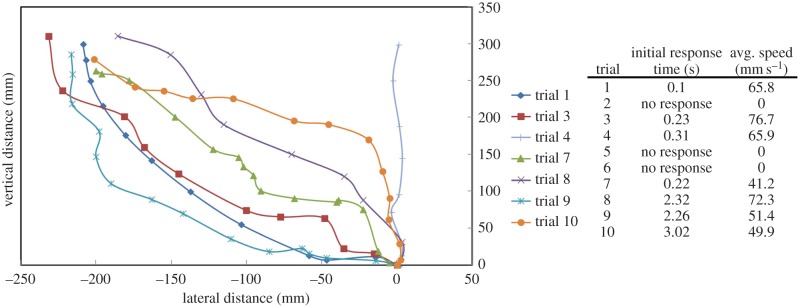
Plot of left paths taken for one roach (R1) over 10 trials. Initial response time to stimulation, and average speed for each trial are tabulated to the right. For trial 4, control was considered a failure as a left turn was not initiated. (Online version in colour.)
Figure 7.

Plot of right paths taken for one roach (R1) over 10 trials. Initial response time to stimulation and average speed for each trial are tabulated to the right. For trials 4 and 7, control was considered a failure as a right turn was not initiated. (Online version in colour.)
Figure 8.
Plot showing the overall rate of success for controlling 10 discoid cockroaches to turn left or right for 10 trials on each side; the average rate of controllability was about 60%. (Online version in colour.)
Once the 20 trials were completed, approximately 1 h, the operator would continue to attempt to control the roach in various directions and to follow various paths. It was observed that over time, the roaches tended to become fatigued and would become unresponsive. The fatigue was brought about by the excessive locomotion of the roach and the repeated electrical stimulation. After a brief 10 min rest period, the roach was able to be controlled again. A roach could typically be controlled for time periods ranging from 30 min to 1 h beyond the initial 1 h experiment. Therefore, using the methodology presented here, a cockroach can be controlled for up to 2 h. Once initial experimentation was completed, the roach was placed back with the colony and not tested again. Future work will include experimentation with the same roach over different time periods to establish longevity. One factor for loss of control was the electrodes shifting out of position owing to the movement of the roach or shifting of the backpack. This minor issue can be alleviated through use of stronger adhesives at the pronotum–electrode interface. The other cause for control loss was the loss of power provided by the battery. This issue can be resolved using a higher capacity battery.
3. Discussion
The success rate of directionality control for tethered experiments was higher than that of remote control; 70% versus 60%. Several factors can explain this disparity: first, the added weight of the electronic backpack and battery will ultimately cause fatigue in the cockroach and cause it to be less responsive over time; second, when the roach is allowed to move freely there is a greater chance for the electrodes to slip out of position; third, the output signal provided by the system-on-chip will tend to degrade as the battery loses power; and finally, human error in control will lead to a reduced reliability. Based on information from the tethered experiments, improvements need to be made to the backpack in order to increase reliability in remote-controlled experiments. The backpack will need to be lighter, with a more efficient power source to output a consistent signal for longer periods of time.
During the course of experimentation, it was noted that left turning in both roach species was much easier to initiate than the right in both tethered and remote-controlled cases. This phenomenon further supports our earlier research asserting that roaches tend to move more frequently toward a left direction and are thus ‘left-handed’ [11]. It was clear from those tests that the locomotion of roaches was contralateral to antenna stimulation, yet turning to one side tended to be easier than the other, regardless of antenna removal [2,11]. In addition, the discoid cockroaches will tend to run at a relatively fast speed when first stimulated. Over time, they tend to walk more slowly and thus become easier to control. However, the consistency in response is ultimately based on the skill of the user controlling the roach. Our experience with these and prior experiments indicates that adult female discoid cockroaches had the highest rate of control. Thus, all tests presented were conducted using female roaches. Larger roaches were preferable, as the current backpack system is large. Next generation systems should be small enough to accommodate smaller animals, such as the American cockroach. Based on our own investigation using blank circuit board material, the American cockroach can best accommodate a 10 mm square circuit board. The wings and body of American cockroaches are not as robust as the discoid, and thus cannot support a payload with a large area. The new system will need to be streamlined to better conform to the back of the smaller roach. In addition, adult American cockroaches can comfortably carry 2 g of payload (approx. 10% of body weight) for at least 2 h. In regard to weight, the limiting factor is the power source. The current battery weighs 1.5 g, which will need to be changed for next-generation systems. However, the current battery may be used if the weight of the circuit board and electronic components can be drastically reduced. Aside from minimizing the area, the use of a flexible polymer circuit board material may be beneficial; it will lighten the system and allow it to better conform to the curvature of the roach's body.
4. Conclusion
A hybrid robotic, remotely controlled cockroach was developed using precise neural stimulation. Neuron interfacing and locomotion control was investigated and successfully implemented in the control of American and discoid cockroaches. The effective control responses were observed when implanting the electrodes inside the area of nerve bundles of the pro-ganglion (ganglion of the first thoracic segment). Stimulating this area with electrical pulses elicit movement in the first set of legs, causing the contralateral leg to become out of phase with the normal gait of the roach. The application of a high frequency, low voltage signal to the left or right sides of the thoracic ganglion of a cockroach will elicit locomotion in the opposite direction of stimulation. Through the control of the input signal using a transmitter, a user can control the locomotion of the discoid cockroach with high repeatability. The work presented herein reports advancement in more precise control of hybrid insects through direct neural stimulation, and opens new research windows for future development using these novel approaches.
5. Future work
Based on the results obtained during the remote-controlled trials, it was clear that a feedback control scheme would be required for more consistency in response of the roach. The current system requires visual feedback from the operator in order to apply the necessary pulse characteristics to control the roach's turning behaviour. This method requires the operator to have extensive experience, as well as constant visual contact with the roach. However, in a real-world situation the deployment of a hybrid roach would not be under ideal laboratory conditions. Therefore, future improvements to our backpack will include onboard sensors that can relay the locomotion behaviour of the roach without having to see its movements. These sensors may include: on-board compass, accelerometer and GPS. Our current backpack system is fully capable of integrating these types of sensors. Based on the sensor feedback, the controller will be programmed to automatically apply the necessary electrical stimulus to elicit turning in a particular direction. This will eliminate user error, and make consistency in response more reliable. Other sensors may also be integrated into the roach backpack that can relay important information about the environment such as temperature, humidity and ambient gases.
6. Material and methods
6.1. Insect selection
Adult American and discoid roaches (Periplaneta Americana and Blaberus discoidalis, respectively) were used in this research. They were reared in plastic containers kept in a dedicated laboratory, which was maintained at a constant temperature of 25°C and 65% relative humidity, in a 12 h alternating light cycle. The insects were provided with water, and fed with dog food ad libitum. The American cockroaches were first studied in order to obtain a basic knowledge of the required stimulation signals for effective locomotion control. American cockroaches (length: 32–35 mm; width: 7–8 mm; mean weight: 6 g) were chosen for this task due to their high availability and resistance, which allowed for numerous testing trials. Even though they are slow walkers, discoid cockroaches were later chosen to test the remote control backpack experiments owing to their larger size (length: 40–43 mm; width: 9–11; mean weight: 7.6 g) which allows for better manipulation of the on-board electronic system. Besides, these bigger roaches are also able to carry larger payloads than American cockroaches. Female roaches are typically larger than male roaches. In addition, preliminary experiments showed that female roaches had a higher rate of control. Thus, only adult female discoid roaches were used in this study.
6.2. Insect's neuroanatomy and signal application
Neuro-anatomical targets were established and simple wire microelectrodes were used to build a neural interface. The first set of experiments were conducted using a tethered insect (American cockroach) in order to obtain stimulation parameters functioned with sufficient reliability. Previous studies done by our group using a tethered American cockroach, with amputated antennae to avoid or diminish other sensory inputs, on a trackball system were conducted, showing a detailed description of the experimental set-up and test results [12]. In summary, American cockroaches were affixed to a stationary platform and made to run on a trackball system after being neurally stimulated. The electrodes used in that study were copper and silver wires, and the output signals were precisely controlled through LabView software. The trackball experiments aimed to determine the optimum stimulation signal for continual control, as well as monitor the physical behaviour of the roach over time as it was repeatedly stimulated. This study gave further insight into the proper placement of electrodes and the optimum stimulation signal for more accurate turning control of the cockroach. The major finding of this study showed that the cockroach's walking and turning behaviour can be initiated by asymmetric electrical potential pulses to the prothoracic ganglion with a success rate of approximately 72%, while previous studies (ours and by other researchers) using electric pulses through the antennal sockets had success rates not larger than 50% [6,12]. In this study, a similar approach was undertaken using free-walking American and discoid cockroaches for remote control, but contrary to our previous research, the antennae of the roaches (American and discoid) were not amputated. Copper wire electrodes were precisely inserted into the prothoracic ganglion and stimulated using various electrical signals.
Throughout the course of this study, the general area of nerves in the ganglia influencing leg movements was identified. As previously mentioned, ganglia of the three thoracic segments (pro-, meso- and metathorax) and the bundles of nerves in contact with leg muscles and wings were studied. This investigation established a map of the various functions responsible for each segment. Figure 9 schematically illustrates the mapping of ganglia, nervous cords and nerve bundles in contact with leg and wing muscles. In general, the nerve bundles located in a particular thoracic segment are responsible for the control of the pair of legs from that segment [14,19,20]. When the pulsed patterns of the electrical signal are sent to the prothoracic ganglion, the locomotion command for the first set of legs will be most affected. The leg located on the side of the stimulation will become out of phase with the contralateral leg on the same segment, therefore, affecting the normal gait of the roach. The stimulated leg will push more toward the side of the roach, thus causing the roach to turn in the opposite direction. Figure 10 illustrates the insertion of electrodes into the prothoracic ganglia of a cockroach. The information gained from the study of American cockroaches was then applied to the larger discoid cockroach, to implement a remotely operated stimulation system. In this study, copper electrodes were chosen as they are readily available and were shown to be electro-chemically responsive to nerve tissue. Studies have shown that over time, tissue and bodily fluids will encapsulate the surface of the electrodes and impede electron flow [12,16]. However, given the 1-h time frame of the experiments, the encapsulation will not be severe as to reduce electrode performance. More effective electrode materials are currently being investigated.
Figure 9.
Schematics of neural mapping of discoid cockroaches and responses to stimulation of some ganglia [13,17,18]. (Online version in colour.)
Figure 10.
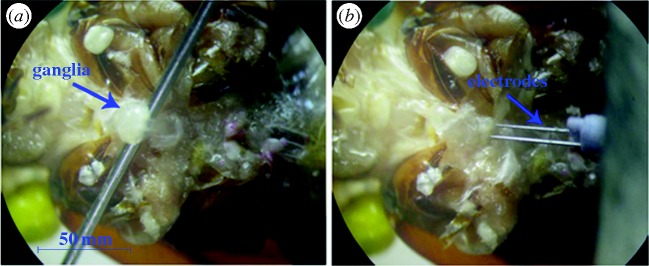
Dissected images of (a) the location of the first thoracic ganglion and (b) placement of two electrodes for localized stimulation in discoid roaches. (Online version in colour.)
6.3. Hybrid system integration
Prior to the electrode implantation and backpack placement, discoid cockroaches were anaesthetized using carbon dioxide for 10–15 s. Next, a cotton swap soaked in acetone was used to carefully remove the thin layer of wax on the pronotum and top wings [21]. White correction fluid was then used to secure the wings in place, in preparation for backpack's attachment. White correction fluid has been used extensively in this and prior studies because it is solvent based and not inhibited by the residual wax coating of the cockroach exoskeleton. In addition, it is easy to apply, quick drying, and once a test is complete it will flake off the roach in just a few days. The tip of a 0.35 mm diameter stainless steel acupuncture needle was then used to puncture two small holes into the pro-thorax; just above the location of the left and right side of the prothoracic ganglion. Each hole will receive two electrodes, a positive and a negative. The electrodes consisted of 0.08 mm, enamel coated, copper wires. Prior to implantation, two strands of wire glued together using a thin layer of cyanoacrylate. A small amount of the enamel coating was then removed from the tips of both wires, ensuring that they did not short the circuit. The opposite ends of the electrodes were then connected to the RF circuit board; one wire from each pair connected to a separate output channel, while the two others were connected to the common ground.
The circuit board, with electrodes and battery connected, was then attached to the top surface of the wings using white correction fluid. A thin piece of wax film (0.5 mm wide, 6 mm long and thickness < 0.12 mm) was then wrapped over the circuit board and around the cockroach's body for more secure attachment. The wax film was placed in a way that did not affect the natural walking movements of the cockroach. The two pairs of electrodes were then carefully placed inside the two puncture holes made earlier in the pronotum. The electrodes were inserted deep enough for the exposed region to lie within the central area of the ganglia on either side. The exact placement of the electrode pairs was chosen and determined through prior experimentation and the overall experience of the researcher performing the implantation [12,16]. Once each electrode pair was placed, a small drop of white correction fluid was used to secure them to the cuticle where they entered the cockroach's body and also to avoid the roaches losing internal fluids. Figure 1 shows a discoid cockroach with electronic backpack, battery and electrodes attached. The entire preparation process took an average of 2 min to complete and was accomplished before the roach was able to recover from the initial anaesthetization.
For the tethered experiments involving American cockroaches, a similar preparation process was conducted. In these experiments, no backpack was placed so there was no need to secure the wings. Also the tip of a 0.35 mm diameter stainless steel acupuncture needle was used to puncture two holes into the pronotum above the left and right portions of the prothoracic ganglia. Similar to the discoid cockroach's preparation, two sets of electrodes were carefully inserted into the holes. The electrodes were prepared the same way as mentioned above. White correction fluid was then used to secure the electrodes in place. Since the roaches were allowed to roam freely in these experiments, a piece of thread was used to secure them to an overhead fixture. This allowed the roaches to walk within a specified radius and helped to prevent the electrodes from being pulled out as they walked. The thread was affixed to the pronotum using a small drop of bees wax. The entire preparation process took approximately 2 min to complete and was again achieved before the roach could fully awaken from the CO2 treatment.
6.4. Radio-controlled stimulation system
The remote system design is similar to the one designed by UC Berkeley for experiments involving remote flight control of beetles [10]. The system-on-chip system was based on the CC2531 by Texas Instruments. This microcontroller system has 21 general purpose I/O pins and an integrated Zigbee wireless protocol. For this research, only two I/O pins were used; one for each stimulation site. Future versions of the system will be able to use more channels for sensor feedback applications. The user was able to send right and left turn commands by pressing buttons located on a transmitter. The receiver on the backpack then delivered the desired stimulus to the cockroach through the implanted electrodes. For this research, the output signal generated by the backpack was set as a +2.5 V (DC monopolar) pulse. The duration and the frequency of the pulse were determined by the length of time in which the button on the transmitter was depressed. This allowed for optimum control by the user. Releasing the button would then cease the output signal. The characteristics of the output signal were determined through experimentation. As the cockroach moved along the floor, the user would apply an electrical signal in an attempt to make it turn left or right. Controlling a free-roaming cockroach proved to be less predictable than controlling one while tethered. As such, the stimulation frequency necessary to initiate a turn with a particular turning radius will vary from roach to roach, as well as the duration of the test due to the roach becoming fatigued. The duration and frequency of stimulation was determined through visual feedback of the user. For example, if the roach did not turn with a short signal at a low frequency, a longer signal at a higher frequency was applied in an attempt to make it turn. Likewise, if the roach turned at a larger radius than expected, the stimulation would be adjusted accordingly.
7. Video of cockroach control
A brief video of a cockroach being remotely controlled can be seen in electronic supplementary material, video S1. In the video, a single operator controls the same roach to demonstrate the robustness of our approach. For purposes of clarification, two LEDs were added to the electronic backpack in order to indicate the intended control direction; the green LED indicates stimulation on the left side of the ganglion thereby initiating a right turn, likewise the blue LED indicates stimulation on the right side to initiate a left turn. The video shows the operator using visual feedback to determine how and when to stimulate the cockroach to control its locomotion in a desired direction. The cockroach in the video displayed a high level of control, at about 65% for the duration of the trials. Overall, the cockroach was able to be controlled for 1 h and was given three 5-min rest periods in-between.
Acknowledgements
This work was in part supported by Space and Naval Warfare Systems Command (SPAWAR Grant) No.: N66001-08-1-2063 and Texas A&M University.
Author contributions
C.J.S., C-W.C. and Y.Z. performed the experiments, C.J.S. analysed the data and prepared the first draft. S.B.V. and H. L. supervised the study. C.J.S., S.B.V., J.M.G. and H.L. thoroughly edited the manuscript. All authors contributed to the interpretation of data. All authors reviewed the manuscript.
References
- 1.Brooks RA. 1989. A robot that walks; emergent behaviors from a carefully evolved network. Neural Comput. 1, 253–262. ( 10.1162/neco.1989.1.2.253) [DOI] [Google Scholar]
- 2.Delcomyn F. 1999. Walking robots and the central and peripheral control of locomotion in insects. Auton. Robots 7, 259–270. ( 10.1023/A:1008928605612) [DOI] [Google Scholar]
- 3.Raibert MH. 1986. Legged robots. Commun. ACM 29, 499–514. ( 10.1145/5948.5950) [DOI] [Google Scholar]
- 4.Melzack R, Wall PD. 1965. Pain mechanisms: a new theory. Science 150, 971–979. ( 10.1126/science.150.3699.971) [DOI] [PubMed] [Google Scholar]
- 5.Shealey CN, Mortimer JT, Reswick JB. 1967. Electrical inhibition of pain by stimulation of the dorsal columns: preliminary clinical report. Anesth. Analg. 46, 489–491. [PubMed] [Google Scholar]
- 6.Holzer R, Shimoyama I. 1997. Locomotion control of a bio-robotic system via electric stimulation. Proc. Int. Conf. Intell. Robots Syst. 3, 1514–1519. [Google Scholar]
- 7.Carlo M, Metin S. 2006. A biomimetic climbing robot based on the gecko. J. Bionic Eng. 3, 115–125. ( 10.1016/S1672-6529(06)60015-2) [DOI] [Google Scholar]
- 8.Mika B, Lee H, Gonzalez JM, Vinson SB, Liang H. 2007. Studying insect motion with piezoelectric sensors. Proc. SPIE 6528, 1–10. ( 10.1117/12.715885) [DOI] [Google Scholar]
- 9.Lee H, Cooper R, Mika B, Clayton D, Garg R, Gonzalez JM, Vinson SB, Khatri S, Liang H. 2007. Polymeric sensors to monitor cockroach locomotion. IEEE Sens. J. 7, 1689–1702. ( 10.1109/JSEN.2007.909624) [DOI] [Google Scholar]
- 10.Hirotaka Sato CWB, Peeri Y, Baghoomian E, Casey BE, Lavella G, VandenBrooks JM, Harrison JF, Maharbiz MM. 2009. Remote radio control of insect flight. Front. Integr. Neurosci. 3, 24. [DOI] [PMC free article] [PubMed] [Google Scholar]
- 11.Cooper R, Nudo N, González J, Vinson SB, Liang H. 2011. Side-dominance of Periplaneta americana persists through antenna amputation. J. Insect Behav. 24, 175–185. [English] ( 10.1007/s10905-010-9246-4) [DOI] [Google Scholar]
- 12.Chiu CW, Sanchez C, Zhou Y, Gonzalez JM, Harlow M, Vinson SB, Liang H. 2012. In vivo neural stimulation for locomotion control of cockroaches. Trends Entomol. 8, 66–73. [Google Scholar]
- 13.Bozkurt A, Gilmour RF, Lal A. 2009. Balloon-assisted flight of radio-controlled insect biobots. IEEE Trans. Biomed. Eng. 56, 2304–2307. ( 10.1109/TBME.2009.2022551) [DOI] [PubMed] [Google Scholar]
- 14.Mu L, Ritzmann R. 2005. Kinematics and motor activity during tethered walking and turning in the cockroach, Blaberus discoidalis. J. Comp. Physiol. A 191, 1037–1054. [English] ( 10.1007/s00359-005-0029-x) [DOI] [PubMed] [Google Scholar]
- 15.Latif T, Bozkurt A. (eds). 2012. Line following terrestrial insect biobots. In 2012 Annual Int. Conf. of the IEEE on Engineering in Medicine and Biology Society (EMBC), 28 August 2012–1 September 2012, San Diego, CA. [DOI] [PubMed] [Google Scholar]
- 16.Chiu C-W, Gonzalez JM, Harlow M, Vinson BS, Liang H. 2012. Electrode–immune system interface monitor through neural stimulation in American cockroach (Periplaneta americana). Electrochim. Acta 68, 81–87. ( 10.1016/j.electacta.2012.02.046) [DOI] [Google Scholar]
- 17.Harris JT, Eisenstein EM. 1999. Transfer of learned information between ganglia in the insect ventral nerve cord. Behav. Brain Res. 103, 211–217. ( 10.1016/S0166-4328(99)00039-X) [DOI] [PubMed] [Google Scholar]
- 18.Eisenstein EM, Reep RL, Lovell KL. 1985. Avoidance and escape components of leg position learning in the prothoracic and mesothoracic ganglia of the cockroach, P. americana. Physiol. Behav. 34, 129–132. ( 10.1016/0031-9384(85)90090-3) [DOI] [PubMed] [Google Scholar]
- 19.Reep RL, Eisenstein EM, Tweedle CD. 1980. Neuronal pathways involved in transfer of information related to leg position learning in the cockroach, P. americana. Physiol. Behav. 24, 501–513. ( 10.1016/0031-9384(80)90244-9) [DOI] [PubMed] [Google Scholar]
- 20.Camhi JM. 1980. The escape system of the cockroach. Sci. Am. 243, 158–172. ( 10.1038/scientificamerican1280-158) [DOI] [Google Scholar]
- 21.Cooper R, Lee H, Gonzalez JM, Butler J, Vinson SB, Liang H. 2009. Lubrication and surface properties of roach cuticle. J. Tribol. 131, 014 502–014 504. ( 10.1115/1.3002327) [DOI] [Google Scholar]



